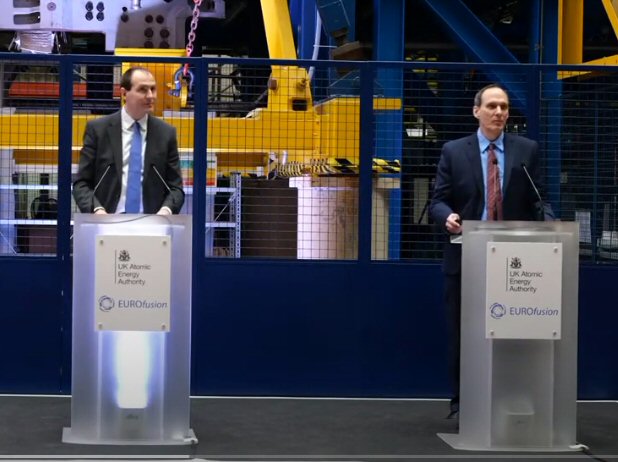#106 Chief Scientist Describes ITER Fusion Reactor Goal Accurately
Return to ITER Power Facts Main Page
By Steven B. Krivit
Feb. 11, 2022

Ian Chapman (l) and Tim Luce (r)
Tim Luce, the chief scientist for the ITER organization, accurately described the goal of the International Thermonuclear Experimental Reactor project earlier this week, a significant improvement from his past communications.
Luce said that the founders of the project had described its goals very specifically, and Luce did the same, saying that the planned output power from the reactor is to be compared to the power that will be used to heat the plasma.
Luce spoke about fusion results that were announced in a press conference at the Joint European Torus reactor project on Feb. 9, 2022:
Our mission is to demonstrate the scientific and technical feasibility of fusion power for peaceful purposes. The men and women who constituted the project defined that very specifically for us, how we’re going to achieve that goal.
Two of the physics objectives are these: that we’re going to reach 500 megawatts of fusion power for at least 300 seconds with an energy gain of 10. By “energy gain” we mean the core plasma generates 10 times more power from the fusion than was put into it to heat it up.
We’re also supposed to demonstrate an “in-principle” steady-state operation, about 300 megawatts, for up to an hour.
So these two metrics, the fusion power and the duration, place ITER in the powerplant class. It will not be a powerplant, but it places ITER as a powerplant class facility in terms of the scientific achievement.
Later in the press conference, Ian Chapman, the head of the United Kingdom Atomic Energy Authority, undid Luce’s good deed. In response to a journalist who asked about the slow progress of fusion research, Chapman created the false impression that the intended goal for ITER is a tenfold gain of the reactor, instead of the plasma — and Chapman wrongly attributed the false claim to Luce.
“We have a high confidence that ITER will reach its goal, and as Tim said, ITER’s goal is to produce a ten-times power gain. You put 50 megawatts in, and you produce 500 megawatts,” Chapman said.
Chapman has had a history of making misleading claims about ITER.

